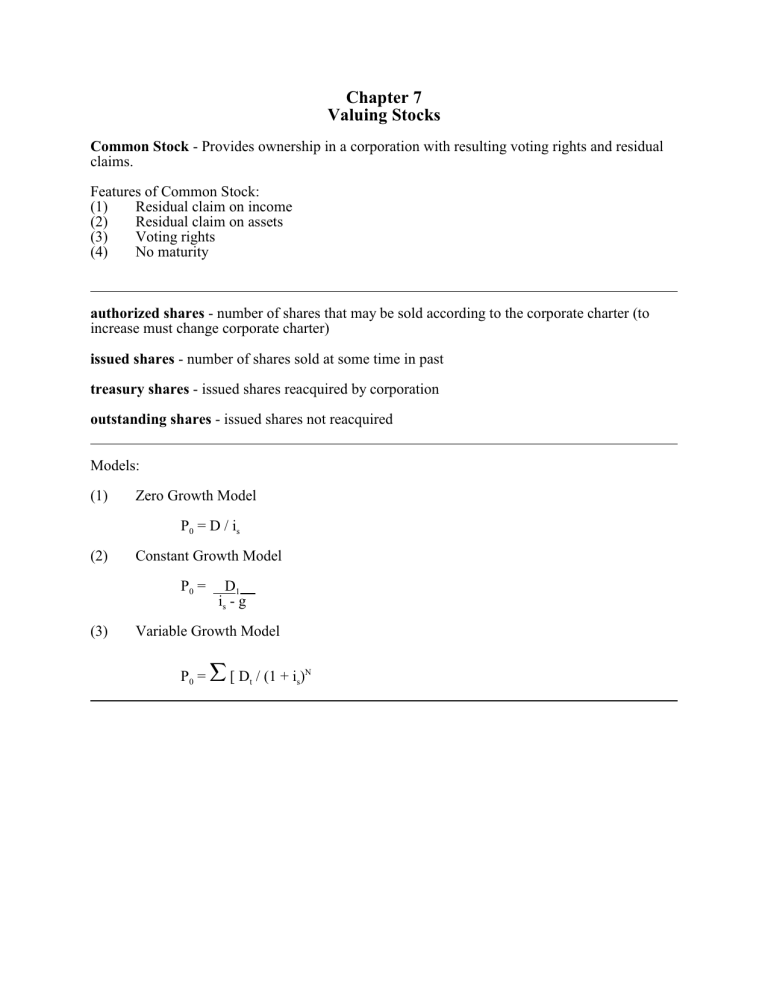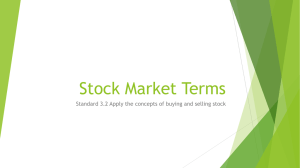Chapter 7 Valuing Stocks

Chapter 7
Valuing Stocks
Common Stock - Provides ownership in a corporation with resulting voting rights and residual claims.
Features of Common Stock:
(1) Residual claim on income
(2) Residual claim on assets
(3) Voting rights
(4) No maturity authorized shares - number of shares that may be sold according to the corporate charter (to increase must change corporate charter) issued shares - number of shares sold at some time in past treasury shares - issued shares reacquired by corporation outstanding shares - issued shares not reacquired
Models:
(1) Zero Growth Model s
(2) Constant Growth Model s
1 i
(3) Variable Growth Model
P = j [ D / (1 + i )
g = growth rate = RR * ROE
RR = retention ratio
ROE = Return on Equity
EARNINGS: (1) paid out as dividends, or (2) plowback into company (Retained Earnings) ex.
payout 40% of earnings as dividends and ROE = 20%, What is g?
g = .60*.20 = 12%
0 percent of earnings as dividends, has a return of equity of 10% (ROE=10%), and a required rate
Value of a share of stock
(1) EPS = $5, i = 10%, no retention. Therefore: 100% payout,
0 1 s
2 4
P = i
D s
= $5
.10
= $50
0 1 2
/))))))))))3)))))))))3
$5 $5
4.55 = ))))))*
4.13 = ))))))))))))))))-
2 3 4
/))))))))3))))5))))3
$5 $5
41.32 = )))))))))))))) P =$50
50.00
(2) Now say retention rate is 50%
EPS = $5,
1 therefore dividend = $2.50, retained earnings = $2.50
say ROE = 10% (note: ROE = i ) s
{does not need to be true} if: ROE > i retain, ROE < i payout s s g = .50 * .10 = 5%
P = D
0 1 i s g
P = 2.50 = $50
0
.10-.05
(3) retention rate = 100%
1 therefore dividend = $0, retained earnings = $5.00
g = 100% * 10% = 10%
How do we value???
i -g
1
g = 10% ( 100% retention )
0 1 2 3
/))))))))))3)))))))))3)))))))))3))))) <
P =? EPS EPS EPS s 1 2 3
=$5 =$5.50 =$6.05
i = 10% ( 0% retention ) s
0 1 2 3
/))))))))))3)))))))))3)))))))))3))))) <
P =? D =5 D =5 D =5
0 1 2 3
.))))) < 0.50
.))))) < 1.05
So, if i =g a 100% retention stock equals in value to a 0% retention stock (all else being equal). s
However if i does not equal g then a 100% retention stock does not equal the value of a 0% s retention stock (note: taxes will also alter this relationship).
(3) Variable growth (Supernormal Growth Example) - accelerated growth for a period of time
- then reverts to constant growth.
ex. new product, new technology, growth company
1 5 g ) < = 6% s
6 i = 10%
1
2
0
D = D (1+g) = 2.16
3
4
2
D = D (1+g) = 3.11
5
6
4
D = D (1+g) = 3.95
0 1 2 3 4 5 6
/)))))3)))))3)))))3)))))3)))))3)))))3))Q
D = D = D = D = D = D =
1 2 3 4 5 6
P = 1.80 2.16 2.59 3.11 3.73 3.95
0
STEP 1
9.82 )))2)))))2)))))2)))))2)))))-
STEP 2
P = 3.95
5
(.10-.06)
= $98.85
61.38 )))))))))))))))))))))))))))-
$71.20
0 rate, an ROE of 14%, a debt ratio of 50% (debt divided by total assets), and investors require a
12% return on investments in Ethel stock. How much is Ethel M Inc. stock worth today?
Park Place Entertainment Incorporated is expected to grow at an exceptionally high rate over the next 3 years due to their forthcoming acquisition of the Montreal Expos Professional Baseball team and its relocation to Las Vegas.
(A) One Analyst estimates that this venture will result in a growth rate in dividends of 25% for the next 2 years and 15% for the third year, before reverting back to a constant rate of 5% that is expected to continue indefinitely afterwards. Assuming this scenario is correct, if Park Place
0 of return of 12%, what is the value of a share of Park Place stock today?
(B) Another Analyst estimates that the venture will result in a 7% constant growth rate in dividends starting today that is expected to continue indefinitely into the future. Assuming this
0 stock is valued according to a required rate of return of 12%, what is the value of a share of Park
Place stock today?
Stock price movement: i -g
ª P
0
ª D - - based on earnings, payout ratio if ª i - - based on company risk, inflation if ª g - - based on earnings, future prospects
Preferred Stock - A hybrid security that has some features similar to common stock and some similar to corporate bonds.
Stock-like Provisions: (1) no maturity, (2) If Dividends payments are missed may give Voting
Rights.
note: If Dividends payments are missed often a cumulative feature,
Bond-like Provisions: (1) Offers a priority claim on assets to common stock, (2) Conversion, (3)
Callable, (4) Sinking Fund.
Valuing: p p where D = annual dividend i p
= required rate of return on PS
What is the value of a share of Oasis Corporation Preferred Stock if it is contracted to pay a
$2.40 yearly dividend. Oasis had earnings of $4.00 per share last year, pays out 35% of its earnings to common stockholders, its ROE is 15%, and the required rate of return on preferred stock is 10%?
•
•
•
•
The Stock Markets
Security issuance (terminology)
< Preemptive rights - when the corporation issues additional shares must give current shareholders right to buy pro rata
Going public - IPO (Initial Public Offering) - when a firm goes from private to public.
Issue additional shares
Primary Market - where common stock is sold for the first time - sold directly to investor
Secondary Market where previously traded shares are bought and sold (NYSE, AMEX,
NASDAQ)
Primary Market Transaction - STEPS:
(1) contact investment banker (advice)
(2) decide on whether to go with a private placement or public issue private placement - sell block of stock to one or a few, minimal regulation public issue - sell in market, more regulation
Who are the regulators - SEC, State (Blue Sky Laws)
(3) file registration statement with SEC - spells out that corp has intent to issue securities - begins
20-day waiting period
(4) file preliminary prospectus with SEC (during 20-day waiting period) - known as a Red
Herring , can give to potential buyers but corp needs approval from SEC before stock can be sold to the public
(5) once the preliminary prospectus is approved then corp can start marketing issue with final prospectus
(6) there are different ways in which an investment banker can be used to market the issue
(a) best efforts - investment banker does not guarantee price
(b) underwrite - investment banker guarantees a price to issuing corporation, underwritten sales usually done through a syndicate (underwriting syndicate) where one investment banker acts as the lead (managing) underwriter. An underwriter assumes risk.
Average Underpricing per year
IPOs per year
Number of
Secondary Market Transaction -
(1) exchanges - organized markets where securities are bought and sold (NYSE, AMEX)
Specialist - acts as a dealer (market maker) on floor of exchange.
(2) over-the-counter - dealers buy and sell (NASDAQ)
Dealers - market makers post bid/ask prices for certain common stocks on computer network
Bid/Ask Spread - example
Wynn Resorts (WYNN)
Close Price = $68.31
Bid = $68.31
Ask = $68.34
Spread = $0.03
The bid-ask spread on IBM Corporation common stock is $130.65 by $130.68.
A.
If you wish to purchase 100 shares at the market price, how much would you pay?
B.
How would you enter a limit order to purchase these 100 shares that would result in the narrowing of the bid-ask spread?
WALL STREET JOURNAL - STOCK QUOTES
YTD
% CHG
21.4
-4.7
-96.6
-0.6
52 W eeks
Hi Lo
14.25
1.81
629.51
282.75
47.44
0.37
29.48
17.08
Stock
M GM M irage
PrchsPro
SowestGas
SYM
M GM
GOOG
PPROs
SW X
Yld
Div %
-
PE dd
38.1
dd
.95
3.3
17.6
Vol
100s
640625
48116
4513
2327
Net
Chg Close
11.95
+1.05
590.48
-9.90
0.59
-0.03
28.47
+0.01
Notes: Google went public (IPO) on August 19, 2004 at $85 per share and closed the first day of trading at $103.34; Purchase Pro quote for 6/30/01.






